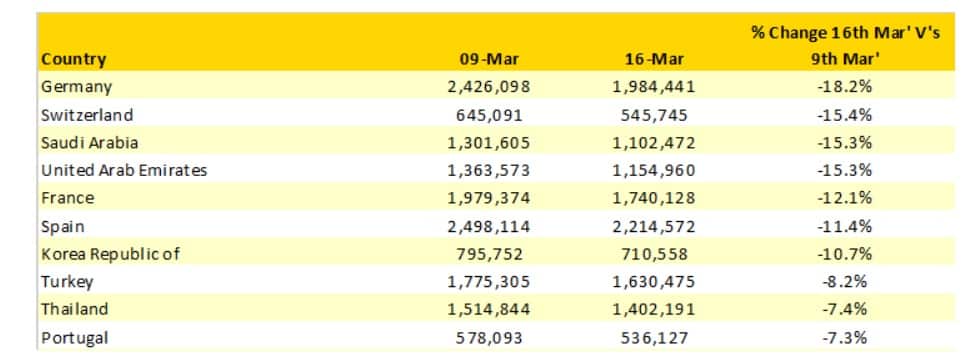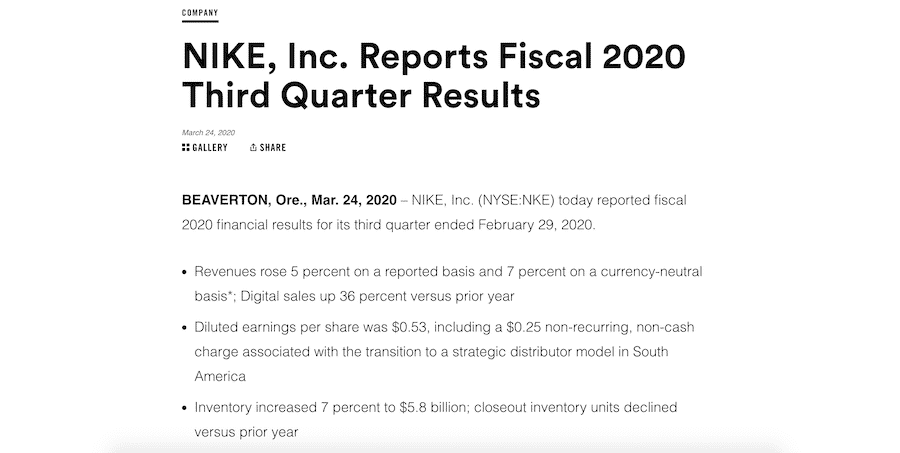From product recalls and data breaches to environmental catastrophes and geopolitical events, a crisis can arise unexpectedly, regardless of the industry you’re in.
In times like this, your business needs a good crisis management strategy that minimizes damage and facilitates a clear path to recovery. One of the key components of this strategy is crisis communication as it helps:
- Keep staff, partners and public informed
- Prevent the spread of misinformation
- Maintain brand credibility and trust
In this article, we’ll share everything you need to know about crisis communication. We’ll cover the best practices for modern businesses and look at inspirational examples of how well-known brands handled operations in difficult times.
The 3 Stages Of Crisis Management
49% of businesses in the U.S. have a formal crisis communication plan. This means that over half of companies are unprepared to communicate clearly and effectively when a crisis hits.
If your businesses is a part of this majority, it’s time to take action.
Before you start developing your crisis communication strategy, you have to understand the three stages of crisis management and which actions you need to take during each of them:
- Pre-crisis: In pre-crisis management, you plan measures to minimize the chances of an internal crisis, and keep an eye on early signs of risk events that may turn into a potential crisis.
- Crisis response: In this stage, you develop a detailed process and solutions plan to address potential adverse events. This includes specific response strategies to reach your stakeholders, customers, investors, employees, suppliers, community groups and more.
- Post-crisis: During post-crisis, you evaluate your response to the crisis and take necessary actions, whether that includes adjusting your plan, making changes inside your organizations or something else.
5 Steps To Create An Effective Crisis Communication Strategy
Having a clear communication strategy is crucial for all three stages of crisis management. It helps successfully pass your message to your audiences during critical times and receive their feedback.
Here are the steps to follow to create an effective crisis communication strategy for your business:
- Develop a crisis plan: Set strict rules and instructions to guide your business during the crisis period. Include specific actions and communication examples referring to your prospects, clients and employees.
- Build a crisis communication/management team: Select the team members who will communicate with your clients and employees and provide support during a critical situation. Ensure each team member knows their responsibilities and has clear instructions on how to act. Define the chain of command so that no information is lost.
- Identify a spokesperson: Choose a person from your team to represent your company’s opinion and position across all communication channels. Having good communication skills is a must. C-suite executives should be ready to step in when needed, as their visibility and authority can help reinforce the company’s message.
- Choose your communication channels: Find your audiences’ preferred communication platforms. When a crisis comes, use those channels to spread your message.
- Analyze your audience’s feedback: Monitor your audience’s engagement and feedback. Try to understand how people feel about your position during a critical situation.
Clear communication during a crisis requires preparation, coordination and a good understanding of your audience. By laying the groundwork early, your team can respond with clarity and confidence when it matters the most.
Crisis Communication In Times Of Disasters: How To Engage Your Audiences During Times Of Uncertainty
One of the most difficult tasks for businesses is to maintain proper communication with their audiences during a crisis.
Whether in times of a natural disaster, local emergency or another emergency, find a way to stay in touch and encourage engagement. This is important for several reasons:
- Brand trust: Your audience needs to know you’re reliable and will be available to help them pull through, in any way you can.
- Brand loyalty: Once you build trust, your customers will be more invested in their bond with your brand.
- Corporate responsibility: Although you may not be responsible for the crisis, you are in charge of handling communication throughout difficult periods. Make sure you demonstrate involvement, empathy and an active effort to alleviate the situation.
Your audience will watch your brand closely during a crisis, waiting for you to show your true character.
Here are a few tips that can help you handle crisis communications effectively:
- Act quickly: First impressions count. Your audience expects to hear from you. Make sure you show optimism, share good wishes and tell your audiences how the situation has affected you. Express emotion and involvement.
- Be compassionate and considerate: The crisis may affect your prospects and clients. They might be scared, stressed and confused. Show that you care and understand what they are going through. Once they feel your empathy, they will be more open to perceiving your message.
- Describe what actions you’re taking to deal with this situation: Be transparent. Set an objective and share how you plan to commit to it.
- Try to help: Find a way to reassure your clients that you support them. Improve your customer care services and increase your social media and website availability. Implement mechanisms so that your clients can reach you in a fast and easy way.
- Take a serious and involved tone: Even if your brand voice is typically entertaining, the situation demands you use a serious tone. Don’t make any jokes. Remember that some of these people may be affected by the situation. Do not turn them away by using an inappropriate tone.
- Don’t take advantage of the situation: Be careful not to use the situation to increase your profit. Don’t dump products or increase prices due to shortage. As successful as it can seem in the short term, it will affect your business negatively in the long run.
- Communicate regularly: Share regularly content on your website and social media profiles to keep your audience engaged. Don’t focus on self-promotion but provide useful tips that can help your users cope with the situation.
We’ll list more examples of how brands engaged their audiences effectively in crisis situations but let’s take a quick look at how Slack handled a major service outage in 2022.
When users began experiencing widespread connectivity issues, the company fixed the issue in a timely fashion, apologized to its users on social media and offered tips on how to get back up and running.
As the situation progressed, they maintained a helpful, calm tone and expressed empathy for their users’ frustrations.
The Use Of AI In Crisis Communication
Businesses today have more tools they can rely on to enhance their crisis communication strategies, with artificial intelligence (AI) leading the way.
This new technology is transforming many aspects of their operations, including how they anticipate, manage and recover from crises.
AI uses machine learning algorithms and natural language processing to scan massive volumes of data to detect early warning signs of crisis situations in their earliest stages. This gives communication teams more time to prepare and allows them to be proactive in high-stakes situations.
Similarly, they can use AI-powered social media monitoring tools that flag misinformation, track real-time conversations and pinpoint trends that could damage their brand’s reputation.
Communication teams are also equipped with AI chatbots that can provide immediate and consistent responses across multiple platforms and help manage public concerns swiftly and effectively.
Another way in which businesses are leveraging AI technology for crisis situations is by running simulations and crisis drills, preparing teams for a wide range of emergency scenarios.
Emphasizing Ethical Storytelling And Personalization
Businesses aiming to maintain trust and credibility during challenging times must incorporate ethical storytelling and personalization into their crisis communication strategies. Modern audiences expect transparency, empathy and authenticity from brands they interact with, especially during times of crisis.
Ethical storytelling involves crafting narratives that are authentic and respectful, ensuring that all communications reflect the organization’s true values and commitment to social responsibility.
Businesses must also demonstrate empathy and responsiveness, as they’re crucial for rebuilding trust during a crisis.
One of the most damaging mistakes a brand can make during a crisis is appearing insensitive or disconnected from the emotional realities its audience is facing.
Crisis Communication Examples & What We Can Learn From Them
Let’s look at four examples of how well-known brands faced and managed crises and emerged stronger after them.
1. Johnson & Johnson
The crisis: In the autumn of 1982, seven people died in Chicago after taking Johnson & Johnson’s market-leading, over-the-counter painkiller, Tylenol.
Over 90% of the American population heard the story within the first week of the crisis, through first newspapers, magazines and hours of TV time dedicated to it.
The reaction: Johnson & Johnson immediately alerted their consumers via advertising and the media not to consume any Tylenol product.
The company stopped the production and advertisement of Tylenol and ordered a national withdrawal of the product.
An investigation by authorities concluded that Tylenol was tampered with in Chicago. The capsules were stolen from stores, poisoned and deposited back onto shelves.
Within six weeks, the company designed the first, triple-lock tamper-resistant container.
Within a few months, Tylenol regained its market share. Johnson & Johnson strengthened their reputation and brand awareness through fast response and adequate measures.
The lesson: The way Johnson & Johnson responded to the Tylenol crisis is widely credited as an example of effective crisis communication. The company focused on values instead of short-term sales and profit.
Johnson & Johnson showed that their customers’ needs came first and demonstrated openness, responsibility and empathy.
This increased the trust both in Tylenol as a product and Johnson & Johnson as a company.
2. Pepsi
The crisis: In 1993, a couple from Washington claimed they found a syringe in a bottle of Diet Pepsi. The complaint was shortly followed by a second similar case.
With complaints pouring in, the company faced accusations about the safety of their drinks, and the crisis threatened to ruin Pepsi’s reputation.
The reaction: In response to the allegation, Pepsi created a video campaign showing how the production and canning process worked — to prove that such a mistake simply wasn’t possible.
Eventually, a video emerged that showed a woman putting a syringe into a can in her own grocery store.
Daily updates, press conferences and close work with the FDA added to Pepsi’s response on the situation.
The lesson: Much like the Jonson & Johnson crisis, the cause was outside of Pepsi’s control. The admirable aspect of their response was transparency.
By allowing customers to look ‘behind the curtain’ and showing them the company’s safe production measures, audiences could understand Pepsi’s perspective and begin to question the allegations.
3. KFC
The crisis: In 2018, due to a delay in chicken meat delivery, KFC’s restaurants in the UK and Ireland faced an unprecedented crisis with numerous complaints from customers.
The reaction: The company’s marketing team placed unconventional ads in newspapers. They threw caution to the wind and rearranged the letters of KFC into a curse word – FCK.
The company allowed customers to track the delivery status of chicken meat in their local restaurants. Every campaign used a consistent, humorous brand voice, which was a crucial part of recovering the company’s reputation.
The lesson: KFC showcased expert crisis management by owning up to the negatives of the situation and providing a clear and transparent response.
The fast food chain recognized the frustrations of consumers, addressed their questions and provided a tool to monitor the situation and provide objective information.
KFC apologises with a full page ad in today’s Metro. A masterclass in PR crisis management.#KFCCrisis pic.twitter.com/ZF4SfAuHl5
— Andrew Bloch (@AndrewBloch) February 23, 2018
4. American Red Cross
The crisis: In 2011, an American Red Cross employee accidentally posted a tweet on the organization’s account instead of his own.
It said:
“Ryan found two more 4-bottle packs of Dogfish Head’s Midas Touch beer…. when we drink we do it right #gettngslizzerd”
The reaction: The American Red Cross didn’t ignore the tweet, trying to pretend it never happened. Instead, they took a humorous approach, and posted a tweet in reply:
We’ve deleted the rogue tweet but rest assured the Red Cross is sober and we’ve confiscated the keys.
— American Red Cross (@RedCross) February 16, 2011
The unusual situation got the attention of Dogfish Head craft brewery. They joined in the conversation and encouraged people to make donations using the hashtag #gettngslizzerd.
The lesson: The American Red Cross managed to mitigate a potentially embarrassing situation and spin it into a positive one that even brought benefits in visibility and donations.
This example emphasizes why organizations should prioritize authenticity in the face of a challenge.
Communication During A Global Crisis: The COVID-19 Pandemic
One of the biggest crisis situations brands across the world have faced in recent years was the COVID-19 pandemic. They experienced financial losses in the face of lockdowns, border closings, travel bans, hybrid working models and more.
The beginning of the pandemic brought catastrophic results that few could have imagined. Businesses strained to keep communication with employees and clients open, empathic and optimistic.
Here’s how companies around the world responded to the COVID-19 pandemic:
- In its news section, Marriott International said that the company had seen a decline of 52.1% in revenue per available room (RevPAR) in Greater China in January and February 2020.
- Between January and March 2020, Beijing saw a 96% decrease in bookings, while Shanghai experienced a 71% decrease.
We will travel again.
— Marriott International (@MarriottIntl) March 27, 2020
Soon, we will step out from behind our screens.
We will look each other in the eye—instead of the camera.
We will clink glasses. We will exchange hugs.
We will travel again.
Until then, stay healthy and stay positive.
We’ll be waiting. pic.twitter.com/MrSHnVeD99
- China, the biggest global supplier of vehicle parts and accessories with $34.8 billion in yearly exports, shut down the factories nationwide, disrupting the automotive global supply chain.
- Between March, 9-6 2020, Germany reduced its flights by 18.2%, Switzerland by 15.4% and Saudi Arabia by 15.3%.

- American Airlines stopped the operation of 55,000 flights globally. As a result, the company saw a decrease of $1.5 billion in revenue in March, compared to the same month last year. [Source: USA Today]
We’re grateful for our loyal customers who remain patient as our Global Reservations team navigates a record number of requests. Your messages of gratitude mean the world to us. Thank you. Your #AATeam‘s committed to helping you during this unprecedented time. pic.twitter.com/3mFzRIF2F9
— americanair (@AmericanAir) March 24, 2020
- The shipment of iOS devices in China decreased from 1.27 million in February 2019 to 494,000 in February 2020, potentially costing Apple billions of dollars.
Although recovery has been slow, borders are opening, lockdowns are ceasing to exist and people around the world are returning to work.
COVID-19 showed the world how vulnerable businesses are to an unexpected crisis and how important it is to be prepared and flexible.
Some industries even managed to identify new business opportunities, incorporate the insights learned in the form of long-term strategies and strengthen their response plans.
For example, In 2020, the multinational sportswear corporation, Nike, closed its physical doors in the US, Canada, Western Europe and New Zealand.
Due to the brand’s flexibility and understanding of consumer behaviors, Nike reported a 36% increase in digital sales in March 2020 and an overall revenue increase of 11% thanks to eCommerce.

Industries like eCommerce, gaming, online communication services and streaming and recruitment platforms that were able to facilitate shopping and provide entertainment during lockdowns recorded new peaks in revenue and user base.
- With almost a third of the world’s population committed to self-isolation or quarantine, the average number of weekly game downloads in China rose by 80% in February 2020 compared to the total 2019 average weekly downloads.
- Zoom went from $1.2 million net income in 2019, to over $15.3 million at the dawn of 2020.
- For the first three months of 2020. Netflix got 16 million new sign-ups.
Facing the new normal, companies across the globe have identified new business models and opportunities.
In addition, companies around the world have invested in crisis communication strategies and crisis management activities.
Unlock Growth Opportunities With Digital Silk
Crisis communication is a mandatory response mechanism in case of unexpected events that disrupt your normal operation and carry risks to your brand reputation.
An effective crisis communication strategy can help you keep your audiences engaged while increasing brand recognition, trust and loyalty.
Some of the key crisis communication tactics to employ are:
- Timely response
- Empathy
- Assistance
- Respect
At Digital Silk, we offer business consulting services for any event that may put your business at risk. Our experienced team took part in growing multimillion-dollar businesses during the global recession of 2008.
We can help you build a communication management strategy — and craft sincere messages to your audience once a crisis arrives. From social media posts to crisis press releases and post-crisis announcements, our experts will ensure you embrace new opportunities and emerge stronger.
Other services we offer include:
Contact us, call us at (800) 206-9413 or fill out the Request a Quote form below to schedule your consultation.
Brands can prepare for crisis situations by conducting risk assessments, running crisis simulations and establishing communication protocols before one occurs. Having pre-approved messaging and a trained crisis response team ensures swift and effective action.
Crisis communication plays a key role in maintaining trust, credibility and transparency during challenging times. How a brand approaches a crisis can significantly impact its public perception, either reinforcing a positive image or causing long-term reputational damage.
Social media can both amplify a crisis and serve as a powerful tool for managing it. It enables brands to respond in real time, directly engage with audiences and have better control over the whole situation. It’s also important to understand that rumors and false information can spread rapidly on social media, making it crucial for brands to monitor conversations closely and address any crisis situations promptly.
Common errors in crisis communication include delayed responses, lack of transparency, ignoring public sentiment and issuing defensive statements. Failing to acknowledge concerns on time and with empathy can escalate public backlash.
To rebuild trust, brands must take responsibility, demonstrate corrective actions and engage with their audience. They can restore credibility by maintaining consistent, authentic communication and showing a long-term commitment to meaningful improvements.
Brands can strengthen customer loyalty by showing transparency, responsiveness and commitment to solutions. A well-managed crisis can enhance brand reputation and demonstrate resilience.
"*" indicates required fields



